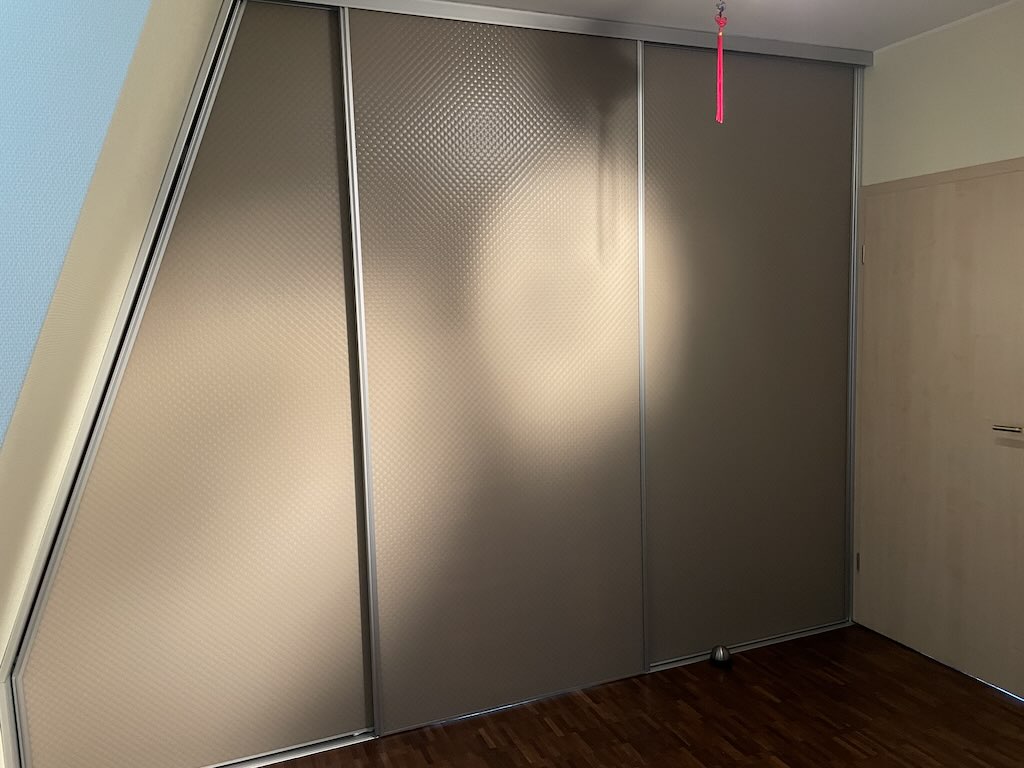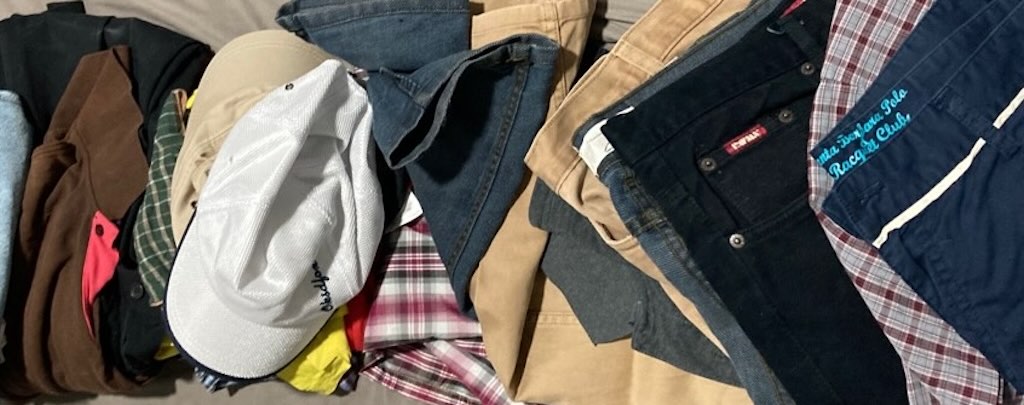This year (2024) we planned to change our old built-in wardrobe, for an all-singing-and-dancing new one. This wardrobe was the private domain of my wife Monique, and the new wardrobe was to be her birthday present. The light of my life passes away on the 23 December 2023, and now I’m left with an empty life and an unwanted wardrobe.
This blog post is all about our new superduper wardrobe (for in my mind everything is still “ours”). I’m not promising to adopt every “best way” to exploit my new doorway to Narnia, but I’ll give it a try. And every time I put something in it, or take something from it, it will reminder me of my lost love, Monique.
Wardrobe, cupboard, closet,..., which is it?
What exactly is a wardrobe? It’s a funny word, because it has several meanings. First and foremost, it’s a piece of furniture in which clothes are kept. But equally it can define all the clothes a person owns. But equally it can also mean a particular type or set of clothes in the sense “she has a different wardrobe for every occasion”.
And it can also refer to a department in a theatre, film company, etc. that is in charge of the clothes that the actors wear on stage, making certain that they are clean, repairing them and sometimes making them.
Thanks to the Online Etymology Dictionary we learn that wardrobe dates back to the early 14th century, to mean a “room where wearing apparel is kept”. Earlier (ca. 1300) it was “a private chamber”. Wardrobe comes from Old North French warderobe, wardereube (Old French garderobe), meaning “dressing-room, place where garments are kept”. This came from warder meaning “to keep, guard” (from Proto-Germanic *wardon” to guard), and robe or “garment”.
Wardrobe meaning “a person’s stock of clothes for wearing” is recorded from ca. 1400. Sense of “movable closed cupboard for wearing apparel” is recorded from 1794. Meaning “room in which theatrical costumes are kept” is attested from 1711, whilst wardrobe malfunction is only from 2004 (and the Super Bowl XXXVIII halftime show controversy).
It’s even more interesting when we see Wikipedia define the walk-in wardrobe as a room “sufficiently big as to allow one to walk into them to browse through the items”. They actually point back to ancient Roman soldiers being the first developers of the modern-day walk-in wardrobe when they invented the armarium, a wooden box for the use of transporting weapons and armour to military camps. Wikipedia does mention that the first true walk-in wardrobe was developed in the Kingdom of France for storing weapons. And of course the French word armoire comes from the Old French armarie (cupboard or bookcase), which derivers from the Latin armarium.
There are a few slang words related to wardrobe. For example, ‘wardrobing’ is wearing something for a short period, then returning it in a such a state that the store has to accept it but can no longer resell it. A ‘wardrobe therapist’ is someone who surgically removes poor fashion choices and replaces the offending items with more flattering/appropriate attire. ‘Wardrobe amnesia’ is when someone finds a piece of clothing or accessory in the back of the wardrobe, but has forgotten why and when they bought it and why they kept it. ‘Wardrobe creep’ is when the man clothes are slowly but surely forced out of the remaining space in a wardrobe (by you know who). A ‘walk-on wardrobe’ is when clothes are just thrown on the floor, and stay there. And finally someone with a poor sense of direction, could “get lost in a wardrobe”.
The first thing to note is that a persons wardrobe does not include things like shoes, which are considered apparel (I refuse to have shoes, etc. in a clothes wardrobe).. The idea is that shoes are an accessory, and apparel consists of clothes and accessories (some functional and some fashionable). So we have garments that covers the body, footwear covers the feet, gloves cover the hands, while hats and headgear cover the head, and of course underwear covers the private parts. Again the word apparel dates from the 13th century and meant “fighting equipment or accoutrements, armour, weapons”, and by the late 14th century meant “personal outfit, a person’s outer clothing, attire”. And we should not forget that by 1859 “to dress” meant “the necessary preparation for every kind of action”, which we still use when we “dress a table”. In the 1500s it meant “sauce used in preparing a dish for the table”. And before we move on we have dressing-up (1852), the “act or fact of attiring oneself with attention to style and fashion”, and dressing-down as a “a reprimand” an American English expression from 1839 originally meaning “a thrashing”.
So back to the wardrobe, and another definition as “a kind of tall cupboard“, which of course begs the question, what is a cupboard? I think that cupboard is an incorrect definition in this context, but it is true that you can find airing cupboards and linen cupboards, but neither are envisaged for clothing.
However ‘tall’ does introduce the idea of a tall rectangular shaped cabinet that clothes can be hung in. And that’s why we have clothes hangers (often also called coat hangers). The late 15th century meaning was “something that is suspended”, and a “thing from which something is hung” is from 1690s. The idea of a “loop or strap in a garment for hanging on a peg” is from 1680s, and the wood or wire coat or dress hanger dates from 1873.
The other important alternative is closet which is just North American English usage for wardrobe, as an enclosed space, with a door, used for storage, particularly clothes. The English have ‘fitted wardrobe’ and the Americans have ‘fitted closet’, both are built into the walls of the house so that they take up no apparent space in the room (and of course both can be walk-in). The origin of the word closet is late 14th century meaning “a small private room for study or prayer”.
What’s nice is that we can add the word-forming element “-ery”, meaning a “place for, art of, condition of, quantity of”, and create some interesting new alternatives to the word wardrobe, such as atirery, clobbery, garbery, getupery, or even a toggery. Togs is English slang for clothes, that derives from the Roman toga, via togman “cloak, loose coat” (1560s), a thieves’ cant word. Whereas clobber is late 19th century British slang “to dress smartly”, but originated for “clobber up“ or to patch old clothes for reuse and conceal defects (1851). The source seems to have been a 19th century noun clobber as a “kind of coarse dark paste used to cover breaks in leather in old shoes”.
To 'dress'
Throughout the above we have strolled along side the word ‘dress’, which has a wide variety of different meanings.
The earliest meaning (ca. 1300) of ‘dress’ would appear to be linked with the Old French dresser, or “make straight, direct, guide, control, prepare for cooking”. Also the Old French drecier meant “raise (oneself), address, prepare, lift, raise, hoist, set up, arrange, set (a table), serve (food), straighten, put right, direct”, and derived from Vulgar Latin directiare “make straight” and from Latin directus “direct, straight”. In cookery (ca. 1500) a ‘dressing’ was a “sauce used in preparing a dish for the table”. I guess this all lead to the ‘dresser’ (or chest of drawers) with shelves in an upper section for storing or displaying tableware. Remembering that chests was traditionally used for storing clothing such as underwear, socks, and other items not normally hung in or otherwise stored in a closet.
The sense of “decorate, adorn” is from late 14th century, as is that of “put on clothing”. The older sense survives in military dress ranks “align columns of troops”. Not sure if it’s related to ‘dressing’, meaning “bandage applied to a wound or sore” (in use by 1713).
We have to wait until ca. 1600, for “a garment or assemblage of garments”, originally any clothing, especially that appropriate to rank or to some ceremony. Wikipedia points to clothing in general, and dress as being a skirt with an attached bodice. It also mentions costume as a distinctive dress style, and even mentions the term ‘fancy dress’.
This leads us to ‘dress up’ meaning “attire elaborately, put on one’s best clothing” (from 1670s), ‘dress down’ or “wear clothes less formal than expected” (from 1960). But you can also ‘dress (someone) down’ meaning to “scold, reprimand” (in use by 1876). In Middle English, ‘dress up’ meant “get up” and ‘dress down’ meant “to kneel”.
This leads us to an expression that I would never associated with myself, and that is “dressed to kill”, meaning to dress in an exceptionally stylish or alluring way. It probably dates from sometime in the 19th century, but almost certainly comes from “dressed to death” first used in 1818 to mean the same thing.
Our new walk-through wardrobe

Our wardrobe has an unusual feature, it occupies an entire wall, and separates our bedroom and bathroom. It has three sliding doors, and the middle one is a door to our bathroom.
It also has interior LED lighting, glass topped draws, trouser rack, etc.










